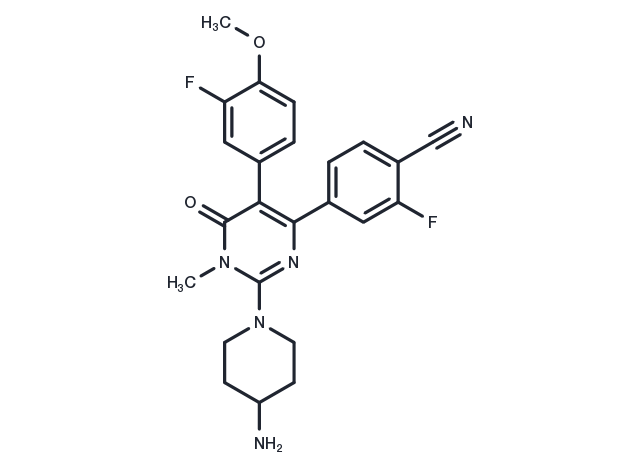Powder: -20°C for 3 years | In solvent: -80°C for 1 year


Pulrodemstat (CC-90011) is a highly potent and selective inhibitor of lysine specific demethylase-1 (LSD1). It exhibits a reversible mode of action and can be administered orally. With an impressive IC50 of 0.25 nM, Pulrodemstat effectively suppresses the enzymatic activity of LSD1. Notably, it demonstrates minimal inhibition against LSD2, MOA-A, and MAO-B enzymes. Moreover, Pulrodemstat possesses remarkable anticancer properties, promoting differentiation in acute myeloid leukemia (AML) and small cell lung cancer (SCLC) cells.

| Pack Size | Availability | Price/USD | Quantity |
|---|---|---|---|
| 5 mg | Inquiry | $ 970.00 |
| Description | Pulrodemstat (CC-90011) is a highly potent and selective inhibitor of lysine specific demethylase-1 (LSD1). It exhibits a reversible mode of action and can be administered orally. With an impressive IC50 of 0.25 nM, Pulrodemstat effectively suppresses the enzymatic activity of LSD1. Notably, it demonstrates minimal inhibition against LSD2, MOA-A, and MAO-B enzymes. Moreover, Pulrodemstat possesses remarkable anticancer properties, promoting differentiation in acute myeloid leukemia (AML) and small cell lung cancer (SCLC) cells. |
| Targets&IC50 | LSD1:0.25 nM (IC50) |
| In vitro | Pulrodemstat (CC-90011, Compound 11) efficiently induces the cellular differentiation marker CD11b in the THP-1 cell line, exhibiting an EC50 of 7 nM, and demonstrates significant antiproliferative effects in AML Kasumi-1 cells with an EC50 of 2 nM[1]. Additionally, Pulrodemstat treatment suppresses GRP in a dose-dependent manner over four days, achieving pharmacologically relevant concentrations (EC50 values of 3 nM in H209 and 4 nM in H1417 cells). Furthermore, a 12-day treatment with Pulrodemstat on SCLC cells leads to notable antiproliferative activity (EC50 of 6 nM in H1417 cells), aligning with GRP suppression[1]. |
| In vivo | Pulrodemstat (CC-90011; 5 mg/kg; orally; daily for 30 days) effectively inhibits tumor growth in patient-derived xenograft models of small cell lung carcinoma (SCLC), showing a tumor growth inhibition rate of 78% without causing weight loss in BALB/c nude mice. Additionally, daily oral doses of Pulrodemstat for 4 days result in significant downregulation of GRP mRNA levels, achieving maximum GRP suppression at a 5 mg/kg dosage in a SCLC human tumor xenograft (H1417) mouse model. Pharmacokinetic studies reveal that, following intravenous administration, Pulrodemstat (Compound 11; 5 mg/kg) displays a systemic clearance of 32.4 mL/min/kg, an elimination half-life of 2 hours, and a high volume of distribution of 7.5 L/kg. Moreover, after oral administration, Pulrodemstat shows good absorption with an area under the curve (AUC 0-24h) of 1.8 μM·h, a maximum concentration (Cmax) of 0.36 μM, and an oral bioavailability of 32%. |
| Synonyms | LSD1-IN-7, CC-90011 |
| Molecular Weight | 451.478 |
| Formula | C24H23F2N5O2 |
| CAS No. | 1821307-10-1 |
Powder: -20°C for 3 years | In solvent: -80°C for 1 year
You can also refer to dose conversion for different animals. More
bottom
Please see Inhibitor Handling Instructions for more frequently ask questions. Topics include: how to prepare stock solutions, how to store products, and cautions on cell-based assays & animal experiments, etc.
Pulrodemstat 1821307-10-1 LSD1-IN-7 CC90011 CC-90011 CC 90011 inhibitor inhibit
